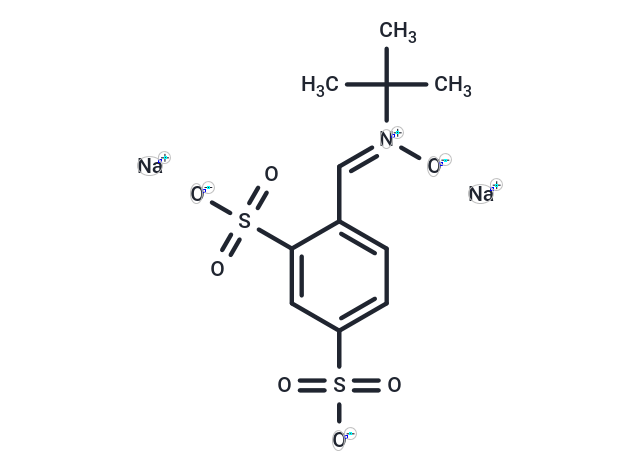Shopping Cart
- Remove All
 Your shopping cart is currently empty
Your shopping cart is currently empty

Disufenton sodium (NXY-059), a new-type nitrone, exhibits potently neuroprotective effects.

| Pack Size | Price | Availability | Quantity |
|---|---|---|---|
| 5 mg | $37 | In Stock | |
| 10 mg | $60 | In Stock | |
| 25 mg | $118 | In Stock | |
| 50 mg | $195 | In Stock | |
| 100 mg | $297 | In Stock | |
| 200 mg | $458 | In Stock | |
| 500 mg | $743 | In Stock | |
| 1 mL x 10 mM (in DMSO) | $40 | In Stock |
| Description | Disufenton sodium (NXY-059), a new-type nitrone, exhibits potently neuroprotective effects. |
| In vitro | NXY-059 is more soluble than the spin trapping agent α-phenyl-N-tert-butyl nitrone (PBN). [1] In an in vitro blood-brain barrier (BBB) model, 250 mM of NXY-059 administered at the onset or up to 4 h after oxygen glucose deprivation (OGD) produces a significant reduction in the increased BBB permeability caused by OGD. Furthermore, OGD produces a huge influx of tissue plasminogen activator across the BBB, which is substantially reduced by NXY-059. [2] |
| In vivo | NXY-059 reduces infarct volume in rats subjected to 2 hours of middle cerebral artery occlusion in a dose-dependent manner. At equimolar doses (3.0 mg/kg for NXY-059 and 1.4 mg/kg for PBN), NXY-059 is more efficacious than PBN. Similar results are obtained when a recovery period of 7 days is allowed. The window of therapeutic opportunity for NXY-059 is 3 to 6 hours after the start of recirculation. [1] NXY-059, a free radical-trapping agent, has a substantial protective effect, lessening the disability caused by an experimentally induced stroke in a primate species. NXY-059 treatment reduces the overall amount of brain damage by >50% of saline-treatment values, with similar levels of protection afforded to both white and gray matter. [3] Treatment with NXY-059 (50 mg/kg subcutaneous plus 8.8 mg/kg/h for 3 days subcutaneous delivered via implanted osmotic pumps) significantly decreases neurological impairment following intracerebral hemorrhage in rat, and reduces the neutrophil infiltrate observed 48 hours post-hemorrhage in the vicinity of the hematoma, and the number of TUNEL-positive cells 48 hours post-hemorrhage at the hematoma margin. [4] |
| Alias | OKN007, NXY-059, NXY059, NXY 059, Cerovive |
| Molecular Weight | 381.33 |
| Formula | C11H13NNa2O7S2 |
| Cas No. | 168021-79-2 |
| Smiles | [Na+].[Na+].CC(C)(C)[N+](\[O-])=C\c1ccc(cc1S([O-])(=O)=O)S([O-])(=O)=O |
| Relative Density. | no data available |
| Storage | store at low temperature | Powder: -20°C for 3 years | In solvent: -80°C for 1 year | Shipping with blue ice. | |||||||||||||||||||||||||||||||||||
| Solubility Information | H2O: 70 mg/mL (183.57 mM), Sonication is recommended. Ethanol: < 1 mg/mL (insoluble or slightly soluble) DMSO: 45 mg/mL (118.01 mM), Sonication is recommended. | |||||||||||||||||||||||||||||||||||
Solution Preparation Table | ||||||||||||||||||||||||||||||||||||
DMSO/H2O
| ||||||||||||||||||||||||||||||||||||

Copyright © 2015-2025 TargetMol Chemicals Inc. All Rights Reserved.